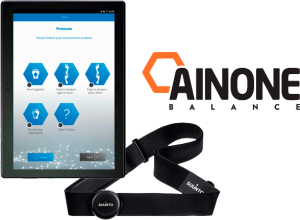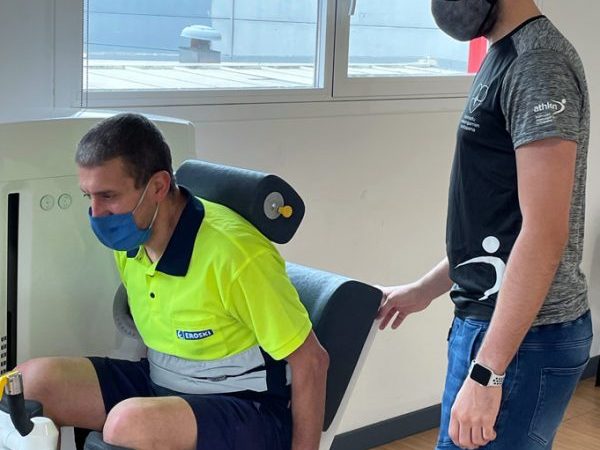How does a person’s balance system work?
Balance is the ability to maintain a desired posture. When our balance system is working properly, we do not take note of how complex it is to actually maintain our balance. However, when the balance system is compromised, it is almost impossible not to notice.
The control of the amount of Body Sway, which is an indicator of balance, is a result from cooperation between multimodal systems. The central nervous system (CNS) receives information (inputs) from three main sensory systems: somatosensory, vestibular and visual system. The CNS analyzes the inputs from these sensory systems and automatically provides corrective outputs by activating the correct muscles. In order to maintain a specific posture, these corrections have to be very delicate and accurate, and this is not a simple task. So there can be a great chance for « miscommunication » between the main components of the balance system. For example a sudden change in input, misinterpretation of the input, delay or failure to send output, or slow processing of the output information can all have an effect on the final outcome – postural balance.
Can data on balance help improve training outcomes?
As healthcare professionals, we do not have the ability to evaluate the timing and quality of the electrical impulses of the neurological system to ensure that the messaging is optimal. However, given the right measurement tools, we have the opportunity to evaluate the output via Body Sway. By changing the input, for example standing eyes closed, we can evaluate the nervous system’s response. This is done by measuring if there is a change in the Body Sway. Defining the change in Body Sway will help the professionals to differentiate the impact of different inputs on person’s balance. Utilizing this data, the healthcare professionals are able to offer better guidance to improve balance in the training/rehabilitation program.
Professionals that work in the area of musculoskeletal training and rehabilitation know and understand the impacts that training can have on neuromuscular learning, muscle activation and coordination, and muscular strength. However, to get the most out of the treatment, goals should be defined in the beginning of the treatment process. Here, the healthcare professional considers the initial assessment and individual needs of the patient to determine the treatment goals. The individual’s exercise therapy program should be tailored to the patient’s own abilities as well as their treatment goals. When designing an exercise therapy program many things must be defined including the right exercises, load progression, and program duration. The same can be said for balance training. Here, a practical and individualized approach is possible with the help of the industry’s leading technology.

Objective balance evaluation supports musculoskeletal care
Pain interferes with balance and therefore, musculoskeletal problems are often reflected in postural stability. There is an association between back pain and reduced standing balance [1]. In people with back pain, the body sway is more rapid and occurs over a wider area than in people without back pain. In addition, the intensity of pain affects sway: the more severe the back pain at the time of measurement, the more sway there is in the forward-backward and lateral directions [2]. In addition to low back pain, the association between impaired balance and lower limb injuries have also been detected [3, 4]. Therefore, balance assessment should be included to patient rehabilitation programs to help clinical decision-making on how to retrain postural control and proprioception.
However, unfortunately too often the balance assessment is “Understood but Underused”. This means that the majority of professionals Understand the importance that balance plays in the overall health, wellness, and quality of life for the individual. However, although it is Understood, due to the unavailability of efficient, quantitative, and reliable clinical testing tools, the full capacity and implementation of balance assessment, treatment, and training remains Underused.
Ainone Balance® is a solution that measures Body Sway objectively, accurately and easily. It gives a numeric value of Body Sway which helps professionals identify the symmetry of body, demonstrate the change and progress and motivate patients to commit to rehabilitation program by providing concrete results.

References
[1] Berenshteyn Y, Gibson K, Hackett GC, Trem AB, Wilhelm M. Is standing balance altered in individuals with chronic low back pain? A systematic review. Disabil Rehabil. 2019; 41(13):1514-1523.
[2] Ge L, Wang C, Zhou H, Yu Q, Li X. Effects of low back pain on balance performance in elderly people: a systematic review and meta-analysis. Eur Rev Aging and Phys Act. 2021;18:8.
[3] Lehmann T, Paschen L, Baumeister J. Single-leg assessment of postural stability after anterior cruciate ligament injury: a systematic review and meta-analysis. Sports medicine-open 2017;3(1):1-12.
[4] Han J, Anson J, Waddington G, Adams R, Liu Y. The role of ankle proprioception for balance control in relation to sports performance and injury. BioMed research international 2015. doi: 10.1155/2015/842804
 Français
Français 
























